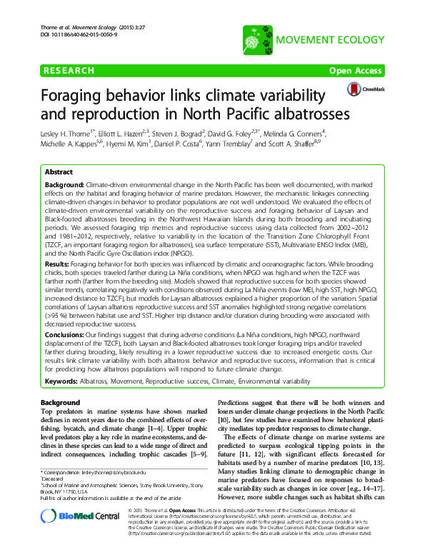
Article
Foraging behavior links climate variability and reproduction in North Pacific albatrosses
Movement Ecology
(2015)
Abstract
Background: Climate-driven environmental change in the North Pacific has been well documented, with marked effects on the habitat and foraging behavior of marine predators. However, the mechanistic linkages connecting climate-driven changes in behavior to predator populations are not well understood. We evaluated the effects of climate-driven environmental variability on the reproductive success and foraging behavior of Laysan and Black-footed albatrosses breeding in the Northwest Hawaiian Islands during both brooding and incubating periods. We assessed foraging trip metrics and reproductive success using data collected from 2002–2012 and 1981–2012, respectively, relative to variability in the location of the Transition Zone Chlorophyll Front (TZCF, an important foraging region for albatrosses), sea surface temperature (SST), Multivariate ENSO Index (MEI), and the North Pacific Gyre Oscillation index (NPGO). Results: Foraging behavior for both species was influenced by climatic and oceanographic factors. While brooding chicks, both species traveled farther during La Niña conditions, when NPGO was high and when the TZCF was farther north (farther from the breeding site). Models showed that reproductive success for both species showed similar trends, correlating negatively with conditions observed during La Niña events (low MEI, high SST, high NPGO, increased distance to TZCF), but models for Laysan albatrosses explained a higher proportion of the variation. Spatial correlations of Laysan albatross reproductive success and SST anomalies highlighted strong negative correlations (>95 %) between habitat use and SST. Higher trip distance and/or duration during brooding were associated with decreased reproductive success. Conclusions: Our findings suggest that during adverse conditions (La Niña conditions, high NPGO, northward displacement of the TZCF), both Laysan and Black-footed albatrosses took longer foraging trips and/or traveled farther during brooding, likely resulting in a lower reproductive success due to increased energetic costs. Our results link climate variability with both albatross behavior and reproductive success, information that is critical for predicting how albatross populations will respond to future climate change.
Keywords
- Albatross,
- Movement,
- Reproductive success,
- Climate,
- Environmental variability
Disciplines
Publication Date
October 1, 2015
DOI
10.1186/s40462-015-0050-9
Publisher Statement
© 2015 Thorne et al. Open Access This article is distributed under the terms of the Creative Commons Attribution 4.0 International License (http://creativecommons.org/licenses/by/4.0/), which permits unrestricted use, distribution, and reproduction in any medium, provided you give appropriate credit to the original author(s) and the source, provide a link to the Creative Commons license, and indicate if changes were made. The Creative Commons Public Domain Dedication waiver (http://creativecommons.org/publicdomain/zero/1.0/) applies to the data made available in this article, unless otherwise stated.
This article was originally published in Movement Ecology Vol. 3, Iss. 27 by BioMed Central on October 1, 2015, DOI: 10.1186/s40462-015-0050-9. The article is also available online at this link.
Citation Information
Lesley H. Thorne, Elliott L. Hazen, Steven J. Bograd, David G. Foley, et al.. "Foraging behavior links climate variability and reproduction in North Pacific albatrosses" Movement Ecology Vol. 3 Iss. 27 (2015) p. 1 - 15 ISSN: 2051-3933 Available at: http://works.bepress.com/scott_shaffer/62/
Creative Commons license

This work is licensed under a Creative Commons CC_BY International License.
